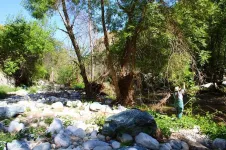(Press-News.org) The night sky has always played a crucial role in navigation, from early ocean crossings to modern GPS. Besides stars, the United States Navy uses quasars as beacons. Quasars are distant galaxies with supermassive black holes, surrounded by brilliantly hot disks of swirling gas that can blast off jets of material. Following up on the groundbreaking 2020 discovery of newborn jets in a number of quasars, aspiring naval officer Olivia Achenbach of the United States Naval Academy has used NASA’s Hubble Space Telescope to reveal surprising properties of one of them, quasar J0742+2704.
"The biggest surprise was seeing the distinct spiral shape in the Hubble Space Telescope images. At first I was worried I had made an error," said Achenbach, who made the discovery during the course of a four-week internship.
“We typically see quasars as older galaxies that have grown very massive, along with their central black holes, after going through messy mergers and have come out with an elliptical shape,” said astronomer Kristina Nyland of the Naval Research Laboratory, Achenbach’s adviser on the research.
"It's extremely rare and exciting to find a quasar-hosting galaxy with spiral arms and a black hole that is more than 400 million times the mass of the Sun — which is pretty big — plus young jets that weren't detectable 20 years ago," Nyland said.
The unusual quasar takes its place amid an active debate in the astronomy community over what triggers quasar jets, which can be significant in the evolution of galaxies, as the jets can suppress star formation. Some astronomers suspect that quasar jets are triggered by major galaxy mergers, as the material from two or more galaxies mashes together, and heated gas is funneled toward merged black holes. Spiral galaxy quasars like J0742+2704, however, suggest that there may be other pathways for jet formation.
While J0742+2704 has maintained its spiral shape, the Hubble image does show intriguing signs of its potential interaction with other galaxies. One of its arms shows distortion, possibly a tidal tail.
"Clearly there is something interesting going on. While the quasar has not experienced a major disruptive merger, it may be interacting with another galaxy, which is gravitationally tugging at its spiral arm," said Nyland.
Another galaxy that appears nearby in the Hubble image (though its location still needs to be spectroscopically confirmed) has a ring structure. This rare shape can occur after a galaxy interaction in which a smaller galaxy punches through the center of a spiral galaxy. "The ring galaxy near the quasar host galaxy could be an intriguing clue as to what is happening in this system. We may be witnessing the aftermath of the interaction that triggered this young quasar jet," said Nyland.
Both Achenbach and Nyland emphasize that this intriguing discovery is really a new starting point, and there will be additional multi-wavelength analysis of J0742+2704 with data from NASA's Chandra X-ray Observatory and the Atacama Large Millimeter/submillimeter Array (ALMA) in Chile. It's also a case for keeping our eyes on the skies, said Achenbach.
"If we looked at this galaxy 20 years, or maybe even a decade ago, we would have seen a fairly average quasar and never known it would eventually be home to newborn jets," said Achenbach. "It goes to show that if you keep searching, you can find something remarkable that you never expected, and it can send you in a whole new direction of discovery."
The Hubble Space Telescope has been operating for over three decades and continues to make ground-breaking discoveries that shape our fundamental understanding of the universe. Hubble is a project of international cooperation between NASA and ESA (European Space Agency). NASA's Goddard Space Flight Center in Greenbelt, Maryland, manages the telescope and mission operations. Lockheed Martin Space, based in Denver, also supports mission operations at Goddard. The Space Telescope Science Institute in Baltimore, which is operated by the Association of Universities for Research in Astronomy, conducts Hubble science operations for NASA.
Explore More
Hubble Science Behind the Discoveries: Quasars
NASA’s Hubble Takes the Closest-Ever Look at a Quasar
Hubble Unexpectedly Finds Double Quasar in Distant Universe
NASA’s Hubble Helps Astronomers Uncover the Brightest Quasar in the Early Universe
NASA’s Hubble Sees the ‘Teenage Years’ of Quasars
Follow Hubble on Social Media: Facebook @NASAHubble, X @NASAHubble, Instagram @NASAHubble
Media Contact:
Claire Andreoli (claire.andreoli@nasa.gov)
NASA's Goddard Space Flight Center, Greenbelt, MD
Leah Ramsay, Ray Villard
Space Telescope Science Institute, Baltimore, MD
END
Hubble reveals surprising spiral shape of galaxy hosting young jet
2025-01-13
ELSE PRESS RELEASES FROM THIS DATE:
Study: US methamphetamine mortality 61 times higher in '21 than 1999
2025-01-13
OXFORD, Miss. – Methamphetamine deaths in the U.S. rose 61-fold from 1999 to 2021, according to a new study, highlighting a growing crisis in addiction and public health.
Looking at the gender breakdown of these deaths could improve harm-reduction efforts and outcomes for patients suffering from addiction, said Andrew Yockey, University of Mississippi assistant professor of public health and co-author of the study.
“We know that, across the board, men are more likely to use every substance except tranquilizers than women, and we found that to be true here,” Yockey said. “Especially if we're thinking about methamphetamine, ...
Atop the Oregon Cascades, UO team finds a huge buried aquifer
2025-01-13
THIS PUBLICATION IS EMBARGOED UNTIL 3 PM EASTERN TIME ON JANUARY 13, 2025.
Oregon’s Cascade Range mountains might not hold gold, but they store another precious resource in abundance: water.
Scientists from the University of Oregon and their partners have mapped the amount of water stored beneath volcanic rocks at the crest of the central Oregon Cascades and found an aquifer many times larger than previously estimated — at least 81 cubic kilometers.
That’s almost three times the maximum capacity of Lake Mead, ...
Bay Area community leader champions CPR education and heart health on national platform
2025-01-13
DALLAS, Jan. 13, 2025 — Corey Bentley, an American Heart Association local volunteer and marketing professional in the San Francisco Bay Area, is the Association’s 2024 National Leaders of Impact™ Winner. In the fall of 2024, more than 300 local leaders in 60 communities volunteered to improve heart health while raising funds to fuel the lifesaving mission of the Association, through its nationwide Leaders of Impact campaign. The head-to-head competition doesn’t just focus on raising critical funds. It also supports access to equitable health in local communities given that health inequities related to uncontrolled high blood pressure rates, tobacco ...
Aston University and Birmingham Children’s Hospital study shows diagnosis and treatment of preschool wheeze needs improvement
2025-01-13
Preschool wheeze is a common condition in children under six, affecting 30-40% of children
Aston University’s Dr Gemma Heath led a study into parents’ experiences of managing preschool wheeze, including confusion and psychological distress
They identified problems with inconsistent terminology and uncertainty around diagnosis and say a unified approach is needed.
A study led by Aston University’s Dr Gemma Heath and Dr Prasad Nagakumar from Birmingham Children’s Hospital, has shown that treatment and diagnosis for preschool wheeze needs more effective ...
Manure management in China cuts river antibiotic pollution but raises groundwater contamination risks
2025-01-13
A recent study published in Environmental Science and Ecotechnology reveals significant changes in antibiotic pollution patterns in China’s water systems over the past decade, driven by evolving manure management practices. Conducted by researchers from China Agricultural University and Wageningen University, the study developed the MARINA-Antibiotics (China-1.0) model to track antibiotic flows from livestock manure into rivers and groundwater across 395 sub-basins between 2010 and 2020.
The study found a 59% decrease in antibiotic pollution in rivers, primarily due to improved manure recycling and reduced direct manure discharge into waterways. However, ...
New book provides big recommendations from the Advancing the Science of Cancer in Latinos Conference
2025-01-13
SAN ANTONIO, Jan. 13, 2025 – With cancer still rising in the U.S. Latino population, leaders at The University of Texas Health Science Center at San Antonio (UT Health San Antonio) and national cancer experts have published an online book with innovative recommendations to reduce Latino cancer.
The book, “Advancing the Science of Cancer in Latinos: 2024 Conference Proceedings,” highlights results of the same-named conference that brought 300 researchers, advocates and survivors to San Antonio in February 2024.
A follow-up conference is planned for Feb. 18-20, 2026, in San Antonio.
Included ...
Ash tree variability may offer restoration path post-beetle decimation
2025-01-13
UNIVERSITY PARK, Pa. — The invasive emerald ash borer, according to the U.S. Department of Agriculture, was first found in the United States in southeast Michigan in 2002. In the decades since, the wood-boring beetle has spread east and west across the U.S. and Canada, killing tens of millions of ash trees, causing one of the costliest forest insect invasions to date. More than 90% of all ash infested by the insect native to Asia eventually die, threatening to make the tree species functionally extinct in North America. In response, researchers at Penn State are working with the U.S. Forest Service and other partners to identify and develop ...
Integrating CRISPR and biomaterials engineering: Paving the way for safer gene therapies
2025-01-13
CRISPR is a powerful gene-editing tool that holds enormous potential for treating genetic diseases by allowing scientists to cut, replace, or delete mutations in DNA. It can also modify gene expression, temporarily amplifying or diminishing its effects.
Yet, despite its promise, applying CRISPR (which is a reagent, or a substance that facilitates a reaction) in patients presents significant challenges.
“CRISPR is difficult to control when you want to do gene editing in vivo, or directly in the patient,” says Tomas Gonzalez-Fernandez, an assistant professor of bioengineering in Lehigh University’s P.C. Rossin College of Engineering ...
New tool for synthetic biology
2025-01-13
Scientists at the University of Stuttgart have succeeded in controlling the structure and function of biological membranes with the help of "DNA origami". The system they developed may facilitate the transportation of large therapeutic loads into cells. This opens up a new way for the targeted administration of medication and other therapeutic interventions. Thus, a very valuable instrument can be added to the toolbox of synthetic biology. Prof. Laura Na Liu and her team published their findings in the journal Nature Materials (DOI: 10.1038/s41563-024-02075-9).
The ...
Yu & Martin adapting mixed reality training programs to real-world scenes to enhance human-AI teaming in emergency responses
2025-01-13
Lap Fai (Craig) Yu, Associate Professor, Computer Science, College of Engineering and Computing, and Joel Martin, Associate Professor, Kinesiology, College of Education and Human Development, received funding for the project: “EAGER: TaskDCL: Adapting Mixed Reality Training Programs to Real-World Scenes to enhance Human-AI Teaming in Emergency Responses.”
This EArly-concept Grant for Exploratory Research (EAGER) project funds research that intends to speed up the development of mixed reality and artificial intelligence (AI) technologies to help ...






